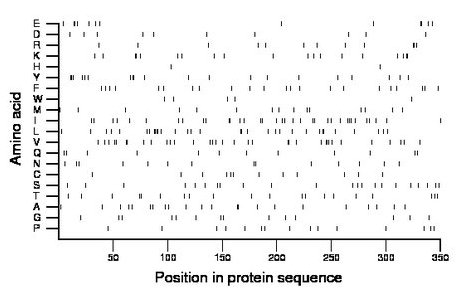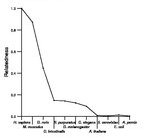
| Name: CCRL1 | Sequence: fasta or formatted (350aa) | NCBI GI: 7706769 | |
|
Description: chemokine (C-C motif) receptor-like 1
|
Referenced in: Chemokines and Their Receptors
| ||
Other entries for this name:
alt mRNA [350aa] chemokine (C-C motif) receptor-like 1 | |||
|
Composition:

Amino acid Percentage Count Longest homopolymer A alanine 6.3 22 2 C cysteine 3.4 12 1 D aspartate 2.9 10 1 E glutamate 3.7 13 2 F phenylalanine 6.3 22 1 G glycine 4.0 14 1 H histidine 0.6 2 1 I isoleucine 10.0 35 2 K lysine 5.4 19 2 L leucine 9.1 32 4 M methionine 4.3 15 1 N asparagine 4.0 14 1 P proline 4.3 15 1 Q glutamine 3.4 12 1 R arginine 3.4 12 2 S serine 6.3 22 1 T threonine 5.7 20 1 V valine 9.7 34 2 W tryptophan 1.4 5 1 Y tyrosine 5.7 20 3 |
Comparative genomics:
Search single species RefSeq proteins at NCBI
Search summary 
Figure data | ||
Related human proteins:Protein Relative score Description Self-match 1.000 chemokine (C-C motif) receptor-like 1 CCRL1 1.000 chemokine (C-C motif) receptor-like 1 CCR7 0.328 chemokine (C-C motif) receptor 7 precursor CCR9 0.326 chemokine (C-C motif) receptor 9 isoform A CCR9 0.322 chemokine (C-C motif) receptor 9 isoform B CCR6 0.290 chemokine (C-C motif) receptor 6 CCR6 0.290 chemokine (C-C motif) receptor 6 CXCR6 0.274 G protein-coupled receptor TYMSTR CCR4 0.268 chemokine (C-C motif) receptor 4 IL8RB 0.263 interleukin 8 receptor beta CX3CR1 0.259 chemokine (C-X3-C motif) receptor 1 CCBP2 0.259 chemokine binding protein 2 CCR10 0.259 CC chemokine receptor 10 CXCR4 0.249 chemokine (C-X-C motif) receptor 4 isoform a CXCR4 0.247 chemokine (C-X-C motif) receptor 4 isoform b CXCR3 0.241 chemokine (C-X-C motif) receptor 3 isoform B CXCR3 0.241 chemokine (C-X-C motif) receptor 3 isoform A IL8RA 0.240 interleukin 8 receptor alpha CCR2 0.238 chemokine (C-C motif) receptor 2 isoform B CCR8 0.235 chemokine (C-C motif) receptor 8 CCR5 0.234 chemokine (C-C motif) receptor 5 CCR5 0.234 chemokine (C-C motif) receptor 5 CCR2 0.234 chemokine (C-C motif) receptor 2 isoform A CCR1 0.226 chemokine (C-C motif) receptor 1 CCR3 0.222 CC chemokine receptor 3 CCR3 0.222 CC chemokine receptor 3 AGTR1 0.213 angiotensin II receptor, type 1 AGTR1 0.213 angiotensin II receptor, type 1 AGTR1 0.213 angiotensin II receptor, type 1 AGTR1 0.213 angiotensin II receptor, type 1Human BLASTP results (used to prepare the table) | |||
Gene descriptions are from NCBI RefSeq. Search results were obtained with NCBI BLAST and RefSeq entries. When identical proteins are present, the self-match may not be listed first in BLASTP output. In such cases, the table above has been reordered to place it first.
See About the Figures for the scoring system used in the figure above right. The same scoring system was used in the table of BLASTP results.
Guide to the Human Genome
Copyright © 2010 by Stewart Scherer. All rights reserved.
